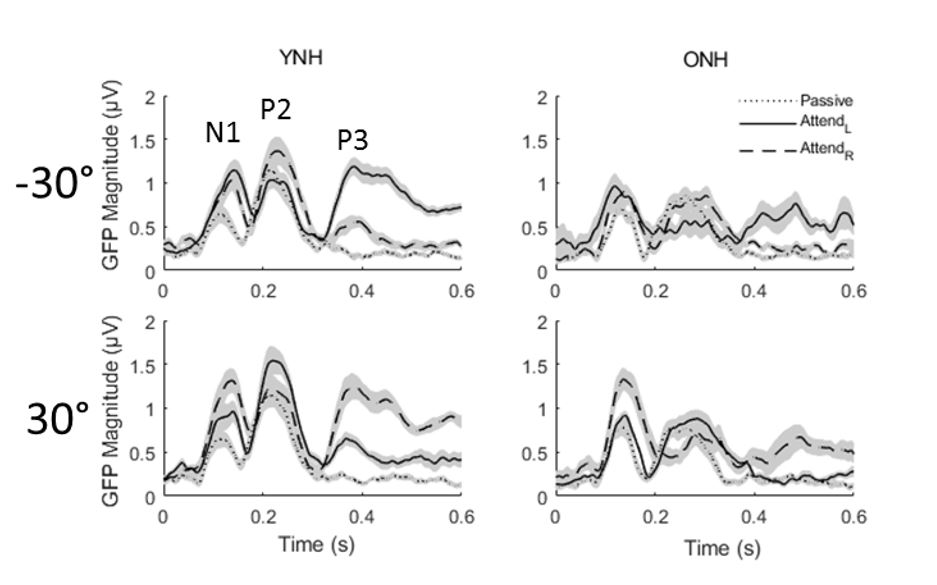Our Research Lab
Aging & Spatial Hearing
The human brain is amazingly precise in the ability to compare and combine sound from the two ears to the advantage of the listener. Listeners use spatial hearing to locate sound sources, to separate one sound from another, and to reduce the negative effects of background noise. Such processing allows us to locate sound sources in space, to quickly and subconsciously build up a "template" representation of room acoustics, and to parse target (more-desired) sounds from background (less-desired) sounds. Our goals are to better understand how these processes decline with age, to identify remediation targets, and to begin to develop methods to overcome any age-related declines in auditory processing. To better understand the neural basis of perception, we also use EEG recordings that involve listening to sounds while we record activity from the brain.
We have completed several projects in this area over the past few years. For example, in one project, we focused on the opponent-channel model of binaural hearing and potential changes in that process with age and hearing loss. Because the power in human communication sounds (speech and music) and competing sounds is greatest at low frequencies, it is of particular interest to understand the processes involved with interaural time difference (ITD) coding. In avian species, ITDs are topographically encoded via cellular arrays tuned to a narrow range of ITDs (Konishi, 2003) as suggested by Jeffress (1948). In mammals, including humans, recent research has pointed towards a non-topographic representation where ITDs are deduced from the relative activity of opposing channels broadly tuned to the two hemifields (see McAlpine, 2005). Electrophysiological studies in young listeners have revealed characteristics of an opponent-channel (OC) model of ITD representation using EEG and MEG (Magezi & Krumbholz, 2010; Salminen et al., 2010; Briley et al., 2013). We have furthered this line of research by focusing on potential changes in ITD coding in older populations. Age-related changes in spatial tuning from either bottom-up, top-down, or both processes may limit the precision with which source locations are coded and may limit the use of spatial cues to segregate targets from competing sound streams. The central hypothesis being evaluated is that spatial tuning and subsequent sharpening due to selective attention decline with age in a manner dependent on specific bottom-up and top-down mechanisms of binaural hearing.
In a recently published study (Ozmeral et al., 2016), we show evidence for reduced temporal processing in older listeners and cortical distribution changes were consistent with other sensory and cognitive processing models of aging. We know, however, that not all binaural processes are coded the same (Ozmeral et al., 2019), suggesting perhaps that along with age-related redistribution of cortical processing, older listeners may also have access and continue to use alternative binaural cues (e.g., interaural level differences [ILDs]) which are not susceptible to declines in temporal processing. In the free-field, in which both monaural and binaural cues are available, we are currently looking at the effects of age and attention on spatial-change processing (Ozmeral et al., 2021). In the figure below, we see that younger listeners (YNH) show robust responses to stimulus onsets in space, and that directed attention to those locations modulate the cortical response. Older listeners (ONH) also show evidence for attentional modulation of responses, but in a more limited fashion. These data have major implications for not only understanding how the brain changes with age, but also how we must target interventions for listeners with hearing-impairment, the majority of which are older. Our upcoming work will focus on the perceptual factors that may be associated with spatial processing with and without hearing aids, with the particular aims to individualize the hearing aid fitting processing that takes into account a broad hearing profile and custom device-feature selection.
